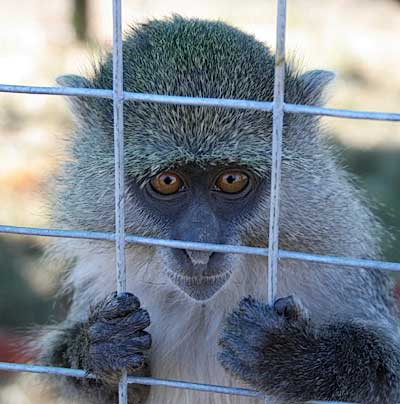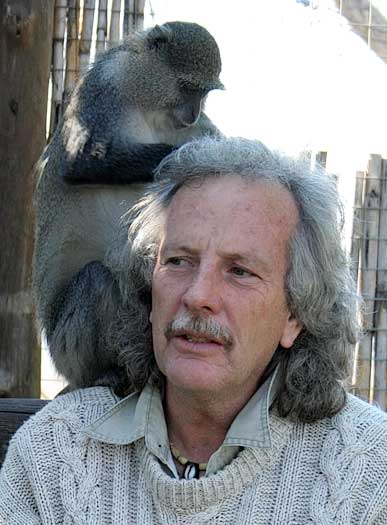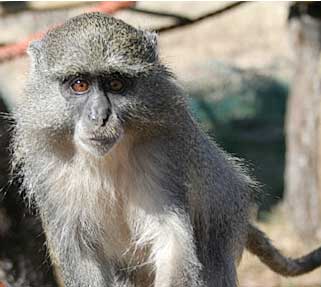Contact Details: Scotch Macaskill, Dirt Road Traders, Currys Post Road, Howick, KwaZulu-Natal, South Africa. Tel: +27 (0)82 578 2329. Privacy: Your privacy is guaranteed. See our Privacy Policy for more. This site accepts advertising and other forms of compensation - see Disclosure and Advertising for details. Site updated: 2022. Copyright © 2002 - 2022 Scotch Macaskill

| ||||||||||
|
||||||||||
A Life Behind Bars for 'Pet' Monkeysby Scotch Macaskill Juvenile Samango monkey - already too "humanized" for release Monkeys behind bars evoke mixed feelings. On one level it's fascinating - and often amusing - watching primate behavior from close quarters. Yet it's also distressing, making one sad that these animals will never experience life outside a cage. Although they're safe and well fed, they'll never breed or benefit from the social hierarchy that binds troops of monkeys in the wild. I was certainly struck by this mix of emotions during a visit to Ishona Langa, a wildlife sanctuary near Pietermaritzburg, my home town in KwaZulu-Natal province. Ishona Langa ("the place where the sun sets") is owned and managed by Victor Hugo, an accomplished wildlife film-maker who is passionate about wild animals. While antelope, zebra, and giraffe wander free across the acacia thornveld that covers the 360-acre sanctuary, it's the handful of captive monkeys that bring both pain and joy to the owner. The monkeys - seven samangos and a couple of vervets - have all been "adopted" over the years by Victor after being abandoned as pets. "People think they can tame these wild creatures because they're so cute when they're babies - but they inevitably bite someone and then become a problem," Victor explains. Because monkeys appear "cute", people treat them like toys. But they're not cuddly playthings that can be picked up and handled at the whim of the owner. Eventually the day comes when the monkey feels threatened by this and bites someone - behaving exactly as it would in the wild.  Samango monkey grooming owner of the sanctuary, Victor Hugo Monkeys Given Free WillIn contrast, Victor allows the monkeys to exercise free will and doesn't force his presence on them.To illustrate this, he enters the cage of a samango monkey and, ignoring it, sits some way off. He explains that if the monkey wants affection, it will approach him. In this case the monkey clearly does want to socialize - it climbs happily over him until, perched on his shoulder, it diligently starts "grooming" his substantial head of hair. Although Victor would dearly love to return the monkeys at Ishona Langa to the wild, it's already too late: "Every day a monkey spends in captivity makes a difference and once they've become too humanized, they become non-releasable". Too HabituatedEven four young samango monkeys he initially hoped could be "dehumanized", are now too habituated to people to survive in the wild.For Victor it's a no-win situation. He doesn't want to keep the monkeys caged, but knows that if released, they won't survive. Either they'll be easy prey for predators or, a greater danger, will inevitably clash with people. Because a monkey raised in captivity has lost its fear of humans, it will eventually enter someone's home, resulting in confrontation and a demand that the monkey be destroyed. As a result, Victor says, no nature reserves or game parks want these monkeys released in their areas. "There's nowhere to let them go free, so we do the best we can, giving them food and shelter." He's now under pressure from other groups to establish a primate sanctuary on his property. But, as he points out, this requires substantial funding and, in the longer term, a place where the animals can be set free. Instead Victor uses Ishona Langa mainly as an educational and conference center, believing the ethos of the sanctuary will "plant a seed in everybody who visits and that they will leave having learnt something". With younger visitors, he uses clever reverse psychology, first allowing them to "ooh" and "aah" over the monkeys before explaining the harsh reality - that these animals are now confined to cages forever because they were initially tamed or kept as pets. The lesson learnt is not to feed or keep monkeys in captivity - leave them wild as they're meant to be. It's something the kids seem to understand and appreciate. 
More About Samango Monkeys
Samangos live in troops of 12 to 20 (but up to 30) usually comprising an adult male, six to eight females and an assortment of juveniles. They sleep at night in trees, foraging in short bursts during the day. They feed on a variety of wild fruits, leaves, flowers, and will also eat insects. Visit the Ishona Langa Wildlife Sanctuary web site or return to Wildlife Info. |
||||||||||